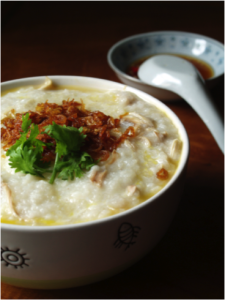
Although the comment wasn’t meant to be spiteful, I found myself dwelling on it. Why is shaming Chinese-Americans for their food so common that the sitcom Fresh Off the Boat made it a subplot of an entire episode? I felt like Eddie Huang, bringing his mom’s homemade noodles to school only for the proverbial American to shout “Ming Ming’s eating worms!” Even a popular children’s picture book discusses the issue of food shaming, centering on a Japanese cat who is teased at school for bringing sushi in her lunch box.
Porridge, or congee, is a Chinese food that dates back thousands of years. A hearty dish of rice boiled in excess water, it has the same stick-to-your-ribs feel of oatmeal and can be made with various toppings, including fish. Porridge’s huge importance comes from the fact that its only ingredients are rice and water, making it a staple across socioeconomic backgrounds. During historic times of famine, porridge could stretch a bowl of rice to feed many mouths. Personally, my mom always made it for me when I was sick—our version of chicken noodle soup.
But instead of educating my peer on porridge, or persuading him that it was tasty, I pondered instead on what separated porridge from Asian staples that had become accepted in mainstream American culture. I doubt he would have blatantly scoffed if Wilbur had offered sushi or boba. Somehow, ethnic foods must be validated by Western cuisine to be considered edible and delicious.
Just take a look at recent popular food trends that borrow from all sorts of cultures: sriracha from Vietnam, pork belly from China, ramen from Japan. No one questions or laughs when I profess my love for chow mein. Even chicken wings, the popular Super Bowl snack, didn’t slip into the mainstream until the 1980s. Today’s cultural diversity in food is relatively new, and I forget the privilege that I have in being able to enjoy and share these foods, compared to my parents, who were told off for “stinking” up the place when they cooked curries in their dorm kitchenettes. But the innocuous comment of porridge being “shocking” brought me back to the reality of being a bicultural student; the reality of still feeling like a foreigner in one of the more diverse universities in America.
In other words, we are a far cry from my parents’ ostracization in 1980s Nebraska. But my acquaintance’s jabs at my culture’s food demonstrate how we also have a ways to go.
Perhaps ten years from now, fish porridge will become a popular menu item of hip farm-to-fork restaurants in San Francisco. But until then, I’ll enjoy the porridge that Wilbur serves every weekend. I invite you to try it too.
Talk to Samantha Wong about food at slwong ‘at’ stanford.edu.
